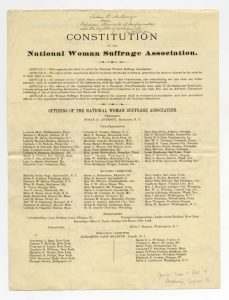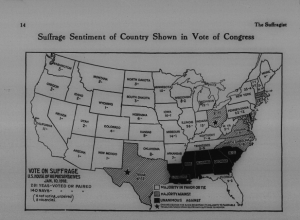Declaration of Sentiments
Modeled after the Declaration of Independence, The Declaration of Sentiments is written to show the parallels between the struggles the Founding Fathers dealt with to those of the women’s movement. The Declaration of Sentiments emerged from the Seneca Falls Convention that is held in New York in July of 1848. The document outlined the rights American women should have as citizens of the United States. This document received harsh backlash and is often mocked in the media. In reaction to this response, while some are frightened, women, particularly Susan B. Anthony, Elizabeth Cady Stanton, and Lucretia Mott, pushed even harder to make suffrage come about.
“We hold these truths to be self-evident: that all men and women are created equal; that they are endowed by their Creator with certain inalienable rights; that among these are life, liberty, and the pursuit of happiness.” Elizabeth Cady Stanton
National Women’s Suffrage Association
Founded by Susan B. Anthony, the National Women’s Suffrage Association works for women’s suffrage and to obtain the right to vote for women. Modeled after the United States Constitution, the Constitution of the National Women’s Suffrage Association outlines both members names and a series of articles describing the organization and its goals. Instead of solely focusing on the right to vote, the NWSA also supports a multitude of reforms aimed to make women equal members of society. In order to achieve suffrage, women had to clearly express what they wanted and fight continuedly for it. Through the Constitution and Declaration of Sentiments, women made their wants clear and worked to achieve those wants.

NWSA Constitution
Votes For Women
In reaction to women’s suffrage, people began to argue that suffrage fails of will bring down a state. In response to these statements, a poster is created and distributed throughout the nation as a counter argument against this notion. In the year of 1915, women’s suffrage is expanding throughout the United States and many states have been adopting suffrage. The spread of women’s suffrage is slow due to being faced with opposition, but while the spread is slow, it is steady. As suffrage spread and is adopted in more states, women became more impowered and began to push for other rights, such as the right to vote. Suffrage was beneficial to society and gave women the platform to build and fight for their rights off of.

The Nineteenth Amendment
Termed the Susan Anthony Amendment, the Nineteenth Amendment is passed on June 4th, 1919 and ratified on August 18th, 1920. The Nineteenth Amendment guarantees that all American women have the right to vote. For many years, as the right to vote is pushed for by women, it had been mocked by others and in the press. Even after Congress passed the amendment, many southern states are adamantly opposed to it. Ultimately, the ratification of the amendment came down to one, singular vote in the state of Tennessee. Finally, the Nineteenth Amendment is ratified, yet it continued to be opposed and disapproved of within the southern states.
“The right of citizens of the United States to vote shall not be denied or abridged by the United States or by any State on account of sex. Congress shall have power to enforce this article by appropriate legislation.”
Suffrage Sentiment
Women’s rights had to be fought for throughout the country, but in comparison to the South, the North is much more accepting of women’s suffrage. On February of 1919, just a few months after the ratification of the Nineteenth Amendment, a map is published showing the popularity and support for women’s rights throughout the country. Through passages and articles, advocates of women’s suffrage spread the idea of women’s suffrage throughout the nation, bringing the countries attention to the cause. Even after the successful fight and ratification of the Nineteenth Amendment, women’s rights continued to be something not fully accepted throughout the country, especially in the Southern regions.

